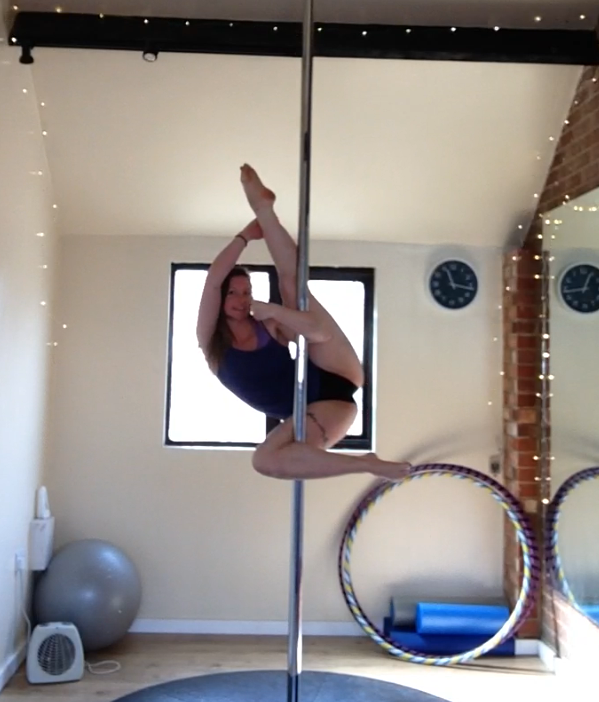Some people have a burning passion to teach. Other people just fall into it. However it’s happened, if you’re interested in becoming a pole instructor there are a few things you need to know.
When you decide to start teaching pole, you must remember that students are putting their trust in your hands. Whether you’ll be teaching lots of group classes at an established studio, or a couple of privates in your spare time at home. They are trusting that you are knowledgeable, safe and professional. When people are paying you to teach them, they have a right to expect these things and you have a duty of care to them. There is a massive difference between showing your friends a couple of moves and teaching the paying general public.
Experience
It may sound obvious, but having experience doing pole is so important to being able to teach pole. When you teach you need to be able to hold moves for longer than you normally would, break down the moves and do each bit super slowly, and often talk whilst you are doing it. This is what I found hard when I first started teaching! It usually takes a long time to build up the strength and pain threshold to do this. You also need good, in-depth knowledge of each move you’re teaching in order to break down what each part of your body is doing. This will mean lots of practise to not only be able to do the move smoothly, but also be very aware of how you’re doing the move so you can teach other people how to do it.
It’s a really good idea to attend group classes at a pole school. This will show you how a class is run, for example How to Warm Up, cool downs, stretches etc. It will also help you to see how different people struggle with different moves, which moves students generally struggle with the most and how the instructor deals with this. It’s very easy to fall into the trap of thinking that because you got a move easily then everyone will. All pole schools teach moves in slightly different orders, generally these are the most common 10 Beginner Pole Moves that you will teach newbies. You will also experience how students react when they get frustrated and watch how is best to deal with this. You will see the different ways people like to learn so you can prepare for how to teach different types of students.
If you are attending a school or are contacting a school to attend and you know you are looking to teach, make sure you are honest with them. Most good schools will be grateful for you being up front. It’s in everyone’s best interests to have good relationships with nearby schools. All instructors have different strengths so it’s helpful to be able to share students rather than students feeling like they have to choose or keep it a secret if they want to attend a lesson elsewhere.
Insurance and First Aid
Having insurance and being first aid trained are absolute must haves. Hopefully you will never have to use them! It is easy to forget that pole can be quite high risk and accidents do happen even in the best instructors classes. Insurance will give protection for you if a student fell, broke their arm, couldn’t work and sued you. Or if your equipment gets stolen/damaged. Or if you get hurt and can’t teach. There are different options and levels of insurance so it doesn’t have to be expensive but it will always be worth it if the worst should happen. Most insurances do require you to be first aid trained. Even if it doesn’t, you should do it just in case someone fell ill or got hurt in your care.
Qualifications
Technically you don’t need a pole qualification in order to teach. This doesn’t mean it isn’t important to consider. Doing a pole qualification will help you learn effective spotting techniques and will help you structure lessons. It also shows potential students that you are committed, professional and know what you are doing. The two main providers are X-Pole and Spin City. A fitness qualification (Exercise to Music or Personal Trainer) is also a good qualification to do. In my opinion, this is more important than just a pole qualification. You will learn a lot more about how the body works and the affects of exercise. This will make you more knowledgeable overall which will reduce the risk of students becoming injured.
Getting Started
You’re an experienced poler, have your insurance sorted, been on a first aid course and have got all of your qualifications, now what? There are two ways you can start teaching. The most common is to get a job at an established pole school. This will probably be at the school you currently attend. Obviously it does depend on whether they are looking for staff and if they think you are the right fit for their school. If you get the job and are an inexperienced instructor, they will probably give you a teaching assistant role to start with. This is really good for building confidence. It’s also helpful as there’ll be another, more experienced instructor with you to help while you grow as an instructor and figure out your teaching style. You’ll also probably just be required to teach moves that you’re told to. Once you become more experienced you may then get to lead your own classes. This may also include writing lesson plans. A lot of studios have their instructors as self employed, if this is the case you will also need to sort out your own tax.
The other option is to open your own studio. This is great if there is nowhere near for you to teach. If there are other pole schools in your area you will need to consider whether there is a market for a new school. This is generally the harder option as you won’t have another instructor to support you during classes. You will also be in charge of dealing with things like insuring the equipment and building, buying the equipment, maintaining the equipment and replacing it, making sure you have first aid kits, cleanliness and upkeep of the studio, setting prices, taking payments, managing cancellations, writing lesson plans, creating par-q’s, consent forms, terms and conditions, cancellation policy and keeping records of all of them, creating a website/facebook page, advertising, answering enquiries. The list is endless! This is pretty much the same if you teach from a home studio or rent a bigger studio. If you have a bigger studio you will just need to do things on a slightly bigger scale. You will also be self employed so you will need to sort out your own tax. If you open a studio you will be running a business so it’s really important to research how to run a business. You could be the best instructor but if you don’t know how to run a business it will be much harder to have a successful school. There are some amazing sources of information out there which can help.
The most important thing is to have fun! It doesn’t matter if you love attending classes or would love to teach, pole is meant to be enjoyed. If you have decided to become a pole instructor, welcome to our amazing little community xx


Comments